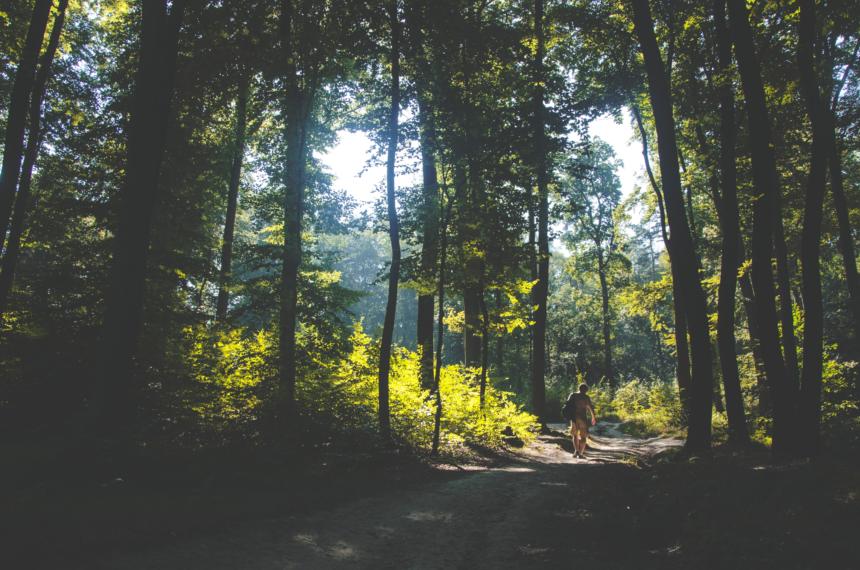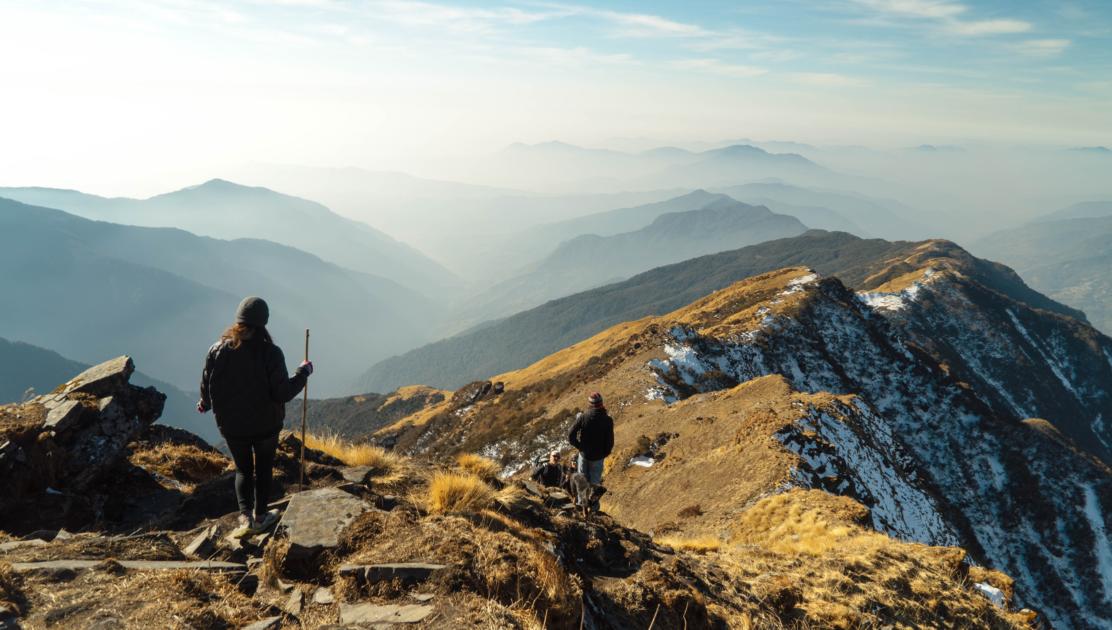On the Virtues of Traveling by Foot
Walking in the Natural World Can Be the Catalyst for Personal Transformation
By Matt MilesThe German filmmaker Werner Herzog once declared “tourism is sin, and travel on foot virtue.” He should know, having once walked all the way from Munich to Paris. His larger point here refers to the authenticity and primacy of physically experiencing and interacting with a place, in contrast to more passive and modern modes of travel. The faster we travel and the more separated we are from our surroundings, the less we can really know of them. We know little of a place traveling through it by car; on a bicycle, our experience broadens; and traveling on foot—one footstep at a time—we come to know a place both physically and intellectually. Traveling on foot can even be a sacred and holy act, as pilgrims from most religious faiths can attest. The means of traveling on foot—or in some cases, on one’s knees—over a long and arduous route are themselves an act of faith that is equally important as reaching the end, whatever that holy site or destination may be.
An idea central to the practice of T’ai Chi is rootedness, the strength and grounding of position that occurs when the body contacts the earth through the feet, establishing a kind of harmonious flow of energy, which is dynamically balanced by fluid movement of the body. Walking or hiking can likewise engage our bodies in a similar kind of kinesthetic experience and harmony with the place through which we are passing. The character of a place may come to us to a certain degree through our senses, but as adventurer and natural navigator Tristan Gooley has written, “We are more likely to understand where we have traveled if we walk it ourselves than if we are carried—even if we are deprived of all of our external senses.”
There is something about immersing oneself physically in a place, I have found, especially over time and across seasons. It yields fascinating insights into a place’s true nature, its unique character. I’ve just as often found, however, that walking in natural or wild places stimulates a kind of depth of thought and contemplation, that—regardless of whether or not it relates directly to the landscape—results in problems being solved, dark moods lifted, ideas elaborated on, thoughts developed. By moving on foot through a place, we undoubtedly come to know that place more intimately. But under the right conditions, free from the constant distractions of home, work, and social interaction, we may also come to know ourselves and our thoughts better.
The English word “discourse” is often used to describe the process of reasoning or logical development, however its Latin root, discurrere, literally means “to run about.” The concept of physical movement or progress giving rise to thought, contemplation, or intellectual development is also reflected elsewhere in common speech, for example, in the use of phrases like “reason through,” “think it over,” or “arrive at a solution.”
As someone who has spent considerable time running, hiking, and walking in the outdoors, I’ve often noticed that I solve more problems and find more inspirations moving about in the outdoors than sitting still at my desk, staring at a computer screen.
Before injuring my Achilles tendon last summer, on many mornings I would enjoy an early run up and down the steep, wooded hills of the Blue Ridge Parkway near my home. Whatever anxieties or concerns I had about the day ahead of me had usually vanished by the end of my six- or seven-mile run. If there was a specific problem or obstacle I was beset by, I would more often than not arrive at an answer or a strategy, if not a complete solution, by the end of the run. On these mornings, my mind was easily soothed by the rustic setting of this daily ritual: the relative absence of automobile traffic and human noise, the sounds of deer rustling through leaves, birdsong emanating from the heights, and hollows of these mostly sylvan surroundings. Even as the route became familiar to me, the daily differences in the subtleties and nuances of light and sound, the changes in temperature, vegetation and wildlife activity were never lost to my attention. On the contrary, they were the energizing catalyst each day for novel thought and inspiration.

In an effort to rehabilitate my injured foot over the summer, and now lacking a regular job commitment, I decided to spend a day each week doing a long hike in the area to compensate both for the lack of physical activity and the lack of time spent in the spectacular natural world of the Blue Ridge, lost to taking a break from running. As June turned to July, I spent many hours wandering nearby trails, particularly sections of the Mountains-to-Sea Trail, a thousand-mile trail that stretches through the Blue Ridge Mountains of North Carolina before it doglegs across the state to the Outer Banks and the Atlantic Ocean. Later in the summer, I explored other destinations a little further afield in Virginia, like Rock Castle Gorge or Grayson Highlands and Mount Rogers, Virginia’s highest peak.
Even during the summer months, however, I saw relatively few other hikers on the more remote sections of these trails and was often left to myself to wander for hours, with nothing but my own thoughts and the cadence of my feet on the trail. Sometimes my thoughts would be focused outward, in tune with the majestic beauty of blue-green peaks stretching away along the horizon of the high country; or the wild flowers lining the path at my feet as it stretched across an alpine meadow. Other times my thoughts drew inwards, as I contemplated a writing project in progress or waxed philosophical about the state of the world. Usually though, over the four or five hours it would take me to do a medium-distance hike, my mind and emotions shifted over a range of thoughts and sensations. At the end of each hike, I found myself physically tired, though never too exhausted. More importantly though, something in me, some deeply human need that transcends the spiritual, emotional, intellectual and physical domains, was satisfied by this time spent alone with my thoughts, ranging across mountainous landscapes, a day at a time.
As much as these weekly rambles changed me in whatever small degree, I have often wondered what it would be like to spend a whole season or the better part of a year traveling by foot. To through-hike the Mountains-to-Sea Trail, or more ambitiously, the Pacific Crest Trail or the Continental Divide Trail, would surely be an unforgettable and life-changing experience, albeit one that many, myself currently included, are not likely to find the time and resources to accomplish. Fortunately, others who have walked or hiked long distances overland have documented their experiences in what some have called “the literature of the leg.” Though this genre is nothing new, I’ve found myself recently living vicariously through the wanderings of several contemporary author-travelers who have undertaken major journeys on foot.
One such writer is blogger and long-distance hiker Carrot Quinn, who has hiked the Pacific Crest Trail in its entirety twice, as well as the Continental Divide Trail and the Hayduke Trail. Quinn’s book, Thru-Hiking Will Break Your Heart, compiles her blog entries from her 156-day traversal of the trail in 2013. The trail begins in the desert at the US-Mexico border and ends at the Canadian border, following the mountainous spine of the high desert, the Sierra Nevada, and the Cascades from south to north. Throughout the book, the reader experiences firsthand the trials and travails of a novice long-distance hiker as she crosses the country that is molding and challenging her body through its extremes of weather and terrain while also flooding her senses with light, wind, and heartbreaking natural beauty. Quinn’s emotional state sometimes mirrors the terrain of the 2668-mile trail: snow covered granite peaks of rapture alternate with deserts of despair and flood-choked valleys of uncertainty, followed by the routine “zero” days in a trailside town, recovering from the exhaustion of trail life. By the end of the journey, though, one is left with a shared sense of loss, of not wanting the trail to end. The reader catches more than a glimpse of just how much trail life—the camaraderie of fellow hikers, and the sheer, gorgeous sublimity of hiking through some of America’s most beautiful country—has changed the author.
Similarly, Nick Hunt’s Walking the Woods and the Water details a journey he made, beginning in December 2011 to retrace the footsteps of Patrick Leigh Fermor, a fellow Englishman, who walked from the Hook of Holland to Turkey’s Golden Horn in 1933. While some of this journey crosses urban and suburban lands, especially in its earlier segments, many of the experiences of people and places Hunt documents could only occur on foot—for example, sleeping in the ruins of an ancient castle along the Rhine River in Germany, or bedding down for the night in a shed while a snowstorm rages outside. As Hunt’s book chronicles his own experiences and the personal changes he undergoes in the seven-month journey, he is also comparing his present-day experience of the lands and people he encounters with Fermor’s account of seventy-eight years earlier and registering the changes, for better or worse, as he notices them. As with Carrot Quinn’s book, one can’t help but feel transformed at the end of this immense yet humble journey across not just the enormity of a continent, but through three seasons and dozens of separate cultures and regions and climates.
Jennifer Stitt, in her recent essay on walking, focuses on the moral clarity that resulted from Thoreau’s solitary walks in the wild and the American civil rights movement as well as past and current freedom movements his thought influenced. A solitary and thoughtful walk in nature here culminates with the mass marches and mobilizations that have brought about deep change and lasting social justice in our time. As I have found also, a solitary walk, especially in the wild, can bring inner peace, wonderful moments of intellectual and visionary clarity, and personal transformation as we physically, spiritually, and intellectually connect with the natural world, which supports us and from which we have evolved. From this position, ecological justice is also possible.
Matt Miles is a writer, poet, permaculturist, maker, and rock climber. His work has previously appeared in Dark Mountain. He lives in the Blue Ridge Mountains of North Carolina where he and Tasha Greer run the reLuxe Ranch, a whole systems farmstead.
Photos courtesy of Unsplash
